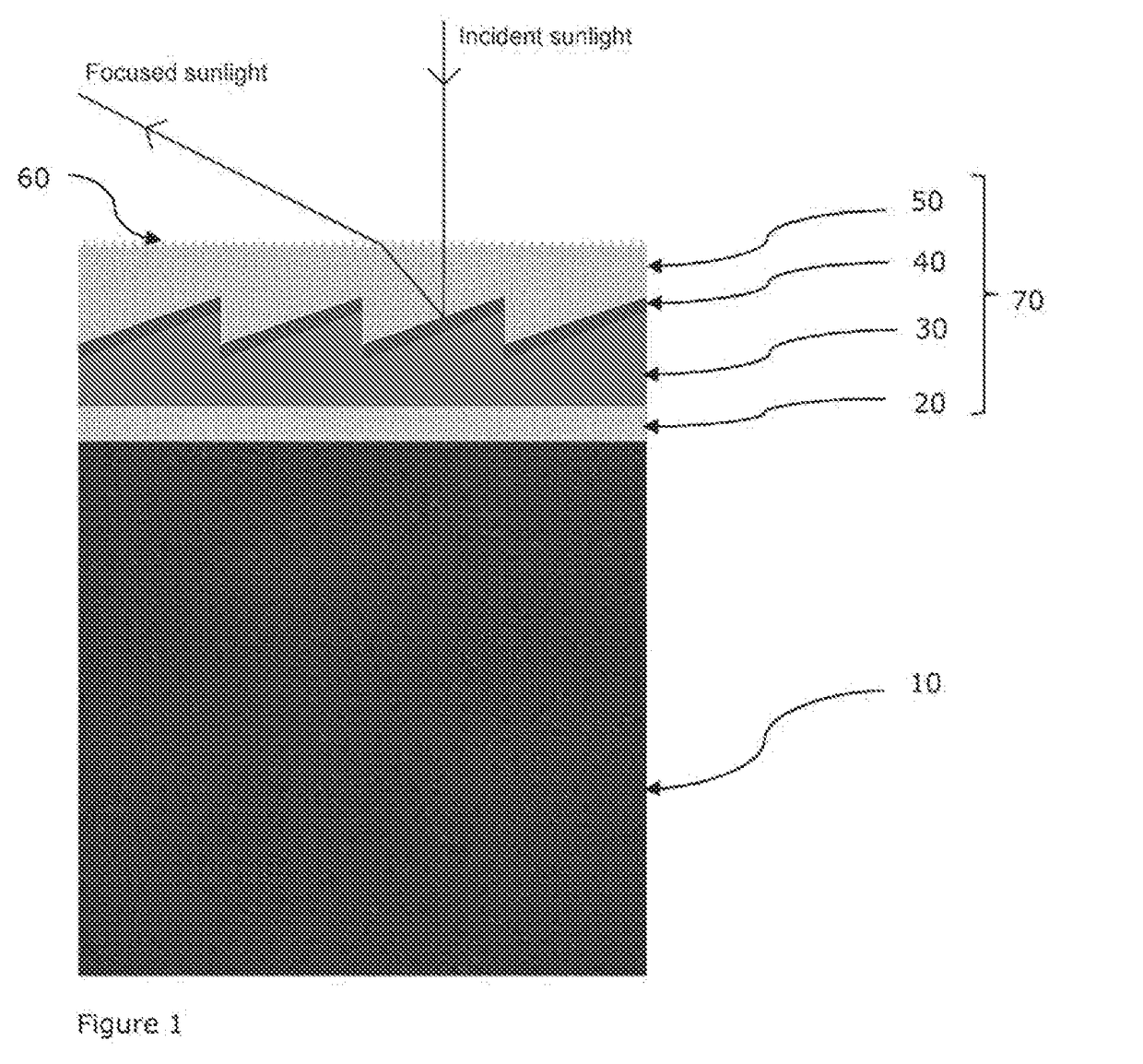Laminate Solar Concentrator
a solar concentrator and lamp technology, applied in the field of optical elements, can solve the problems of concentrated devices not providing all the desired aspects, namely simultaneous precision, energy loss, maintenance costs, etc., and achieve the effects of simplifying maintenance, reducing barriers to replacement, and enhancing durability
- Summary
- Abstract
- Description
- Claims
- Application Information
AI Technical Summary
Benefits of technology
Problems solved by technology
Method used
Image
Examples
example 1
[0149]Two half-parts of a lens with dimensions 2200 mm×2800 mm and focal depth of 2200 mm is manufactured in a PET-Surlyn foil laminate, having a total thickness of 140 μm, resulting in a weight of approximately 160 g / m2. The foil laminate is coated by a pressure sensitive adhesive and laminated to a 4 mm mechanically rigid float glass (having a weight of approximately 10 kg / m2, thereby forming a stable optical element. The optical efficiency of the optical element is measured to 65%.
[0150]The stable optical element is mounted in a frame on a solar tracker. A water-based receiver is placed in the focal point absorbing the focused sunlight, thereby heating up the water, which is used for district heating.
[0151]After 3 years of use, the efficiency of the focusing part of the optical element (the foil laminate) has been lowered to 50% through weathering, abrasion and UV degradation. To restore the efficiency of the optical element, the focusing foil is being removed by applying a force...
example 2
[0152]A lens with dimensions 1450 mm×1450 mm and focal depth of 2000 mm is manufactured in a PET-PP foil laminate, having a total thickness of 150 μm, resulting in a weight of approximately 170 g / m2. The foil laminate is coated by a temperature sensitive adhesive and laminated to a 4 mm mechanically rigid float glass (having a weight of approximately 10 kg / m2, thereby forming a stable optical element. The optical efficiency of the optical element is measured to 75%. The stable optical element is mounted in a frame on a solar tracker. A thermal oil-based receiver is placed in the focal point absorbing the focused sunlight, thereby heating up the thermal oil, which is used for combined heating and power generation.
[0153]After 3 years of use, the efficiency of the focusing part of the optical element (the foil laminate) has been lowered to 65% through weathering, abrasion and UV degradation. To restore the efficiency of the optical element, the focusing foil is being removed by heating...
example 3
[0154]A reflective lens with dimensions 2200 mm×2800 mm and focal depth of 1200 mm is manufactured in a PET-PP-Aluminum foil laminate, having a total thickness of 300 μm, resulting in a weight of approximately 320 g / m2. The foil laminate is coated by a solvent sensitive adhesive and laminated to a 5 mm mechanically rigid aluminum plate (having a weight of approximately 12 kg / m2, thereby forming a stable optical element. The optical efficiency of the optical element is measured to 50%.
[0155]The stable optical element is mounted in a frame on a solar tracker. A thermal oil-based receiver is placed in the focal point absorbing the focused sunlight, thereby heating up the thermal oil, which is used for combined heating and power generation.
[0156]After 2 years of use, the efficiency of the focusing part of the optical element (the foil laminate) has been lowered to 35% through weathering, abrasion and UV degradation. To restore the efficiency of the optical element, the focusing foil is ...
PUM
 Login to View More
Login to View More Abstract
Description
Claims
Application Information
 Login to View More
Login to View More - R&D
- Intellectual Property
- Life Sciences
- Materials
- Tech Scout
- Unparalleled Data Quality
- Higher Quality Content
- 60% Fewer Hallucinations
Browse by: Latest US Patents, China's latest patents, Technical Efficacy Thesaurus, Application Domain, Technology Topic, Popular Technical Reports.
© 2025 PatSnap. All rights reserved.Legal|Privacy policy|Modern Slavery Act Transparency Statement|Sitemap|About US| Contact US: help@patsnap.com



